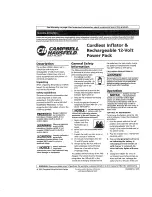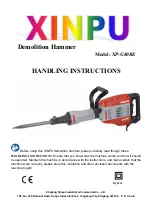
7
Cap nozzles
• The air-blast nozzle (8) protects panes of glass,
for example, from being heated up by diverting
the air current.
• The reducing nozzle (9) produces a precise air
current which can be used for deforming syn-
thetic materials, for example.
• The reflector nozzle (10) produces a flat air cur-
rent which can be used for thawing frozen water
pipes, for example.
Check before switching on!
Check the safe condition of the product:
– Check that the air inlet openings are not
blocked.
– Check all parts to make sure that they fit tightly.
– Check whether there are any visible defects:
broken parts, cracks, etc.
Switching on/off
– Attach the required cap nozzle (
– Connect the product to the power supply.
– Point the nozzle at the surface to be treated.
– Switching on: Set the On/Off switch (6) to posi-
tion [I]–[III].
– Set the temperature using the buttons (3).
• The set temperature is shown in the display (4).
– Set the air flow using the buttons (5).
• The set air flow rate is shown in the display (4).
– Switching off: Set the On/Off switch (6) to posi-
tion [0].
– As soon as the work is completed pull out the
mains plug and put the product on its stand (7)
to let it cool down (
Cleaning and maintenance
Cleaning the product
Careful handling and regular cleaning ensure that the
product remains functional and efficient for a long
time.
– Wipe down the product with a slightly damp
cloth.
– Never spray the product with water or expose it
to water.
– Never use detergents or solvents for cleaning.
This can cause irreparable damage to the prod-
uct. The plastic parts can be eaten away by the
chemicals.
– Keep the air inlet openings and nozzle clear of
impurities and blockages.
Storage and transport
Storage
• Allow the product to cool off completely before
storing.
• Store the product in a dry place.
Transport
• Use the original packaging to ship whenever
possible.
Troubleshooting
If something isn’t working…
Malfunctions are often caused by minor faults. You
can easily remedy most of these yourself. Please
consult the following table before contacting the
vendor. You will save yourself a lot of trouble and
possibly money too.
WARNING! Risk of injury!
The nozzle
must not be replaced until the device has
cooled off and has been disconnected from
the mains.
DANGER! Risk of injury!
The product
must only be put into operation if no
defects are found. It is crucial that any
defective parts are replaced before the
product is used again.
NOTICE! Risk of product damage!
Always maintain a minimum distance of
25 mm between the nozzle and the surface
to be treated.
NOTICE! Risk of product damage!
Never
use the product with the air inlet openings
pointing downwards. Dirty air can be
sucked in.
NOTICE! Risk of product damage!
The
product must always be used with one of
the cap nozzles.
DANGER! Risk of injury!
Use the stand (7)
for resting the device. Don’t put the device
down on any inflammable surface.
DANGER! Risk of injury!
Switch off the
product and disconnect the mains plug
before all cleaning and maintenance work.
Wait until all moving parts have come to a
complete stop and the product has cooled
down.
DANGER! Risk of injury!
Make sure that
unauthorized persons do not have access
to the product!
DANGER! Risk of injury!
Improper repairs
can result in the product functioning
unsafely. This endangers yourself and your
environment.
GB
Heissluftpistole_301452.book Seite 7 Mittwoch, 16. September 2015 2:10 14
Содержание HLP-2000 LCD
Страница 3: ...3 7 6 5 8 9 4 1 3 2 10 1 2 Heissluftpistole_301452 book Seite 3 Mittwoch 16 September 2015 2 10 14 ...
Страница 4: ...4 7 3 Heissluftpistole_301452 book Seite 4 Mittwoch 16 September 2015 2 10 14 ...
Страница 14: ...14 Heissluftpistole_301452 book Seite 14 Mittwoch 16 September 2015 2 10 14 ...
Страница 15: ...15 Heissluftpistole_301452 book Seite 15 Mittwoch 16 September 2015 2 10 14 ...


































